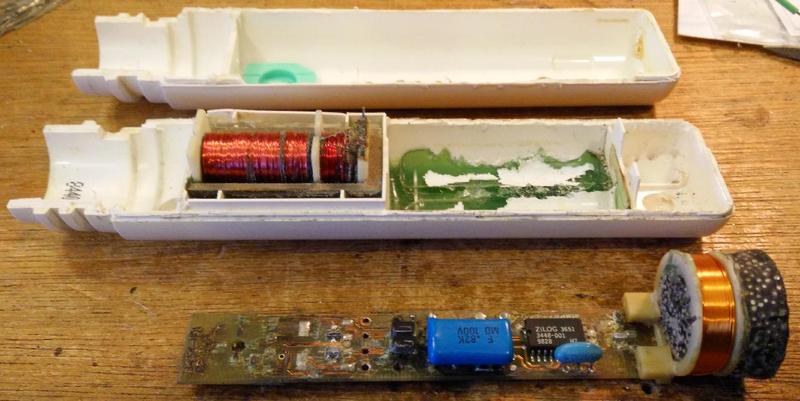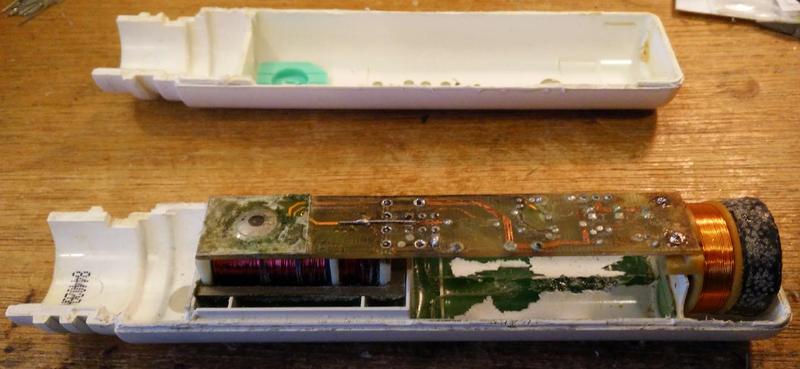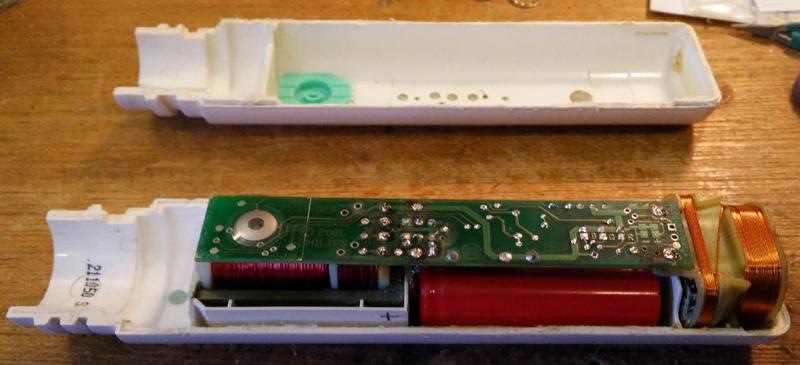Repair Sonicare Advance Toothbrush
Sonicare Advance toothbrushes are pretty old, now. Unless you've kept it charged properly, and didn't store it in the charger base, the NiCd batteries are probably dead. If you stored it in the charger base all the time, then it's likely that the charge coil is "burned" (insulation burned off and full of shorted turns). If you didn't keep the body dry, then the circuit board may also have corrosion on it.
Note: Click on the pictures to embiggen.
Early style Advance showing re-wired charge coil, no batteries, corroded board, and burned insulation in drive coil.
The coil on the left is the drive coil. It has two sections. The left most, longer section is a resonator. That coil and the blue capacitor on the circuit board resonate at the sonicare frequency (about 240Hz) to make the motor more efficient.
The short right hand section of the drive coil is a center tapped coil that is driven by the two transistors that are left of the blue cap. They are hooked up in a push-pull configuration, so that the coil can be driven harder from the 2.5 volts the NiCd batteries provide.
The dark rings that look like dirt on the coils are actually burned insulation, which means this drive coil is probably garbage.
The coil on the right is the charge coil. That black cylinder on the right is an iron core. When the toothbrush is inserted into the charge base, the iron core and wire coil form part of a transformer, to couple AC current into the toothbrush so that the battery will charge.
The green "stuff" in the plastic housing is the remains of the glue that was used to attach both coils and the batteries into the housing. You can remove the batteries from the glue by slitting the battery's plastic sleeve, pulling out the batteries, and then tearing the plastic sleeves out of the glue.

Assembled early style Advance showing re-wired charge coil, no batteries, corroded board, and burned insulation in drive coil.
You can see the other side of the circuit board. That green crud on the left end is under the clear plastic insulating tape that holds the push button together. I've put a jumper wire on the board where it appeared to me that the copper had corroded completely away. This Sonicare led a hard life, ridden hard and put away wet -- literally. The corrosion is probably due to the toothbrush getting too wet too often.
The charge coil looks nice and new, and that's because it is. If you can chip/drill etc the green glue enough to pry the charge coil out of the handle, you can remove the old wire and re-wire it. The wire is 30ga by my measure, and there are three layers of about 16 to 18 turns on each layer, for about 48 to 54 turns total. Note that the later Sonicare Advance model has a different charge coil (see below).
I don't think I'm going to be able to save this Sonicare. The circuit board is too far gone (the charge LED is missing, somehow!) and the drive coil is burned. I'll just use it for spare parts.

Later style Advance showing re-wired charge coil and new NiCd batteries. On this one, the charge coil was burned (shorted turns due to burnt insulation) and the batteries were dead, but the rest of the unit was in good shape.
I managed to use a small drill to drill away enough of the green glue that I could free the charge coil from the body, and then I pulled off the old wire and re-wound it. Again, it's 30ga enamelled wire, three layers on the wide section, and then 6 more turns in that smaller section. After winding the new coil, I sprayed it liberally with clear coat spray paint, since I don't have a pot of lacquer to dip it in. This keeps the wire in place, and prevents buzzing.
There are many eBay sellers who will sell you NiCd or NiMH batteries for your Sonicare. I bought NiCd, but NiMH have similar enough charge characteristics that they'd probably work OK. Some vendors warn you off of the NiMH batteries because they're not exactly the same. It's up to you, I don't have a strong opinion.
This unit is back in service now, with it's new batteries and charge coil. It took a long time to charge fully, but the newer Advance brushes actually let you know when they're fully charged. During charging, the green LED blinks slowly, and when fully charged, the LED lights steadily.

"Frankensteined" style Advance showing with double AA battery holder with AA NiCd batteries.

"Frankensteined" style Advance showing with double AA battery holder with AA NiCd batteries.

"Frankensteined" style Advance showing with double AA battery holder with AA NiCd batteries. This was my first Sonicare Advance, and when the batteries died, I decided to make them field replaceable. I cut the unit apart, cut out a section of the case, lengthened the wires from the charge coil to the circuit board (by about 1/4 inch) and then glued in a double AA holder.
This unit worked for a while, and then started quitting mid-brush on me. Eventually, I figured out that it was bad vias on the circuit board. Re-soldering each and every via on the board fixed the problem. It took going over some of the vias twice, but eventually I got it. I've debated restoring it to "stock" but soldering in the proper batteries and glueing the case back together, but I haven't bothered so far.
I haven't figured a good way to get the cases apart for repair. The best I can suggest is to use a razor knife to try to weaken the glue joint while you pry the case halves apart at that little slot up in the thread area (where the brush head mounts). Some of the ones I've split haven't been too bad, and others have been awful.
To glue the cases back together, I use Goop, because it's flexible, and can be removed easily. So if you need to get back into the Sonicare, you can just pry it apart with a screwdriver, pull off the Goop, and you're all set. E6000 is essentially the same stuff, and I find it easier to buy in toothpaste sized tubes.
About the Author
Mr. Dudley is a retired electrical engineer and computer programmer.
William Dudley
December 06, 2015





 Views
Views